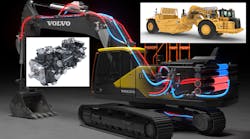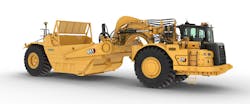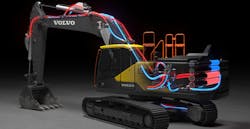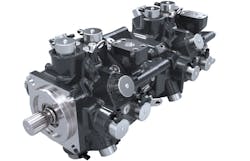Electrohydraulic Disruption: New Technologies Steer the Way Forward
At a Glance:
- In the energy debate, hydraulic systems are framed as inefficient energy hogs.
- Newer advancements, including electrohydraulic technologies, are well-suited for certain uses.
- OEMs are targeting new hydraulic system architectures that can incorporate electronics in off-highway equipment for increasing efficiencies and maximizing effectiveness.
When major automakers announced a pivot to electric vehicles last year, their collective declaration marked an inflection point.
GM demarcated its shift toward widescale EV production with a corporate logo change. The new logo featuring the letters “gm” in lowercase, noted the automaker, ushers in a new vision for “a world with zero crashes, zero emissions and zero congestion.” The letter “m” was purportedly underlined as a nod to the company’s Ultium battery cell platform.
More than a shift in tone, electrification is playing a pivotal role in the transformation of mobility. Many OEMs have set end dates for internal combustion engine (ICE) vehicles. In the U.S., new regulatory targets aim for an EV share of at least 50% by 2030.
Electricity use is expanding at twice the rate of any other form of energy and drives an imperative to deliver smart, safe and sustainable transport systems and solutions. As emission standards around the world grow more stringent, the pressure mounts to create more efficient electric and hybrid vehicle solutions. The recently enacted infrastructure bill is allocating more than $7 billion in funding across the battery supply chain for battery materials refining, processing and components manufacturing.
Yet, despite the all-out push for electrification, practical and technological hurdles continue to hamper EV sales, including the limited range on these vehicles and the dearth of charging infrastructure. In 2020 there were roughly 25,000 Level 2 fast-charging stations in the U.S., compared to 115,000 gas stations.
Consider the zero emissions equation. Even if 50% of vehicles are electric by 2030, the obvious query remains: What happens to the remaining 50%?
Fluid power experts tell us that the ambition and demand required from regulatory emissions targets still outpace the speed at which the industry can optimize returns from electrification. In a recent interview with Power & Motion, Eric Alstrom, president of Danfoss Power Solutions said the trend is encroaching on all segments of the fluid power industry. “What we’ve learned during the pandemic is that, especially now with significantly increasing supply chain costs, it makes perfect sense both for our flexibility but also from a cost perspective to be more local,” he said.
With electrification moving to the forefront in the coming years, decision-makers will be critically assessing product portfolios for components that see slowing demand in the face of continuous improvement and costs, and opt instead for technologies that deliver cleaner and greener options.
Hydraulics Hold a Trump Card
Even as electric power transmission is proving to be cleaner and more efficient, and as electronic controls integrate with existing technologies, hydraulics remains unsurpassed when it comes to power density, pointed out Mitch Eichler, a business development manager at Parker Hannifin’s Motion Systems Group. “It’s hard to beat the power ratio of hydraulics,” he said. “High-force, high-demand applications still are largely done by hydraulic valves.”
The good characteristics need to be weighed against the bad in each application, Eichler said.
“In some applications, components are going more electromechanical for its motion control capabilities. But with all the energy that it consumes, it would be size- and cost-burdensome to drive everything this way.”
Prototyping and Use Cases
While some OEMs plan a wholesale overhaul of their product lines, others are phasing in new hydraulic system architectures that can incorporate electronics in off-highway equipment for increasing efficiencies and maximizing the effectiveness of hydraulic technology. Examples in the field are becoming ubiquitous.
Electrohydraulic upgrades. Consider Caterpillar’s self-propelled Cat 651 Wheel Tractor Scraper (WTS). This new single engine was big news at CES earlier this year, and has re-entered the market with upgrades to the powertrain, controls, hydraulics and overall design.
Its single engine design features the Cat C18 engine powering the tractor with 469 kW (629 hp) and meets EU Stage V/U.S. EPA Tier 4 Final emission standards. Advanced Productivity Electronic Control System (APECS) fully integrates the transmission and engine drivetrain to provide smooth and responsive shifts. The scraper can load 104,000 lb of material in 30 sec. (In the U.S., the 651 scraper is usually tandem pushed by a D10-sized tractor for optimum payload and cycle times.)
Caterpillar noted that improvements to the hydraulics include an electrohydraulic implement system for improved multifunction capability and a short throw for the T-handle implement control. And, with a high-pressure steering system that requires significantly less steering effort—therefore reducing fatigue—efficiencies to the work cycle and operator experience have been enhanced.
Energy recovery. A Volvo Construction Equipment team unveiled a ground-breaking new system architecture for excavators last year. Aimed at reducing energy losses in hydraulics, the new system architecture was being tested in the field. The machine’s work functions are connected to a hydraulic energy storage via a common pressure rail, comprised of two or more pressure lines. The energy storage (hydraulic accumulators) enables energy-efficient recovery of kinetic energy and peak power supply.
For cylinder-driven functions, so-called “smart actuators” are used to achieve energy-efficient conversion from hydraulic power to a variable force and speed, noted Volvo’s team. The system can recover energy and increase performance of the machine’s rotating loads, such as the swing function through the introduction of variable hydraulic machines. With more power available, cycle times can be reduced (for example, when loading a truck), which contributes to both efficiency increases and cost benefits for users.
Improved duty cycle. When Danfoss engineers analyzed the energy flow in excavators, they discovered that 70% of the useful energy made by the engine disappeared as waste heat. Danfoss has developed its Digital Displacement (DDP) technology to help address this by simply swapping out the conventional pump. Replacing a standard pump with a single- or multi-outlet 96cc Digital Displacement Pump can significantly increase the productivity of hydraulic machinery, enhance control and reduce energy consumption, they noted.
According to Danfoss, DDP technology can cut fuel consumption in excavators by 25-30%. The technology uses a radial design, which enables pistons in real time, using ultra-fast mechatronic valves controlled by a dedicated controller.
“It is digital hydraulics for the digital age,” said Niall Caldwell, director, Danfoss Digital Displacement. “It is going to be a very creative phase for the whole industry as we learn how to apply the technology to solve a myriad of problems that customers have.”
Regaining ground. This new generation of hydraulic fluid power solutions shows that OEMs and vendors alike are open to innovative design considerations and developing competencies aimed at optimizing performance of hydraulic systems in tandem with electrified powertrain architecture. With new ways of thinking and systems approaches, they’re able to carve a niche for hydraulics that promises to be more efficient, flexible and reliable.




